
These two issues were unusual in that the plates were produced by etching. In 1932, the two plates were etched in copper while in 1933 a single steel plate was used. The plates had 60 stamps in 6 rows of 10.
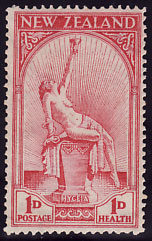
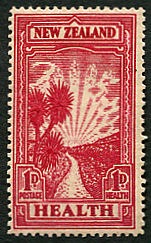
The 1932 design represents the Goddess of Health, Hygeia, reclining on a pedestal. The designers were W J Cooch and R E Tripe and the die was engraved by H T Peat in Wellington.
The 1933 design represents the pathway to health and was designed by J. Berry.
The stamps cost 2d, 1d for postage and 1d which went towards health camps for children.
In both years, the stamps were printed at the Government Printing Office in Wellington on paper watermarked NZ and star and had a line perforation of 14.
For the first time, the 1d surcharge was denoted Health rather than Charity. The first recorded illustrated Health first day cover was produced by the Kiwi Exchange Club for the 1933 Health issue although it is interesting that the logo on the cover was N.Z. Charity Issue and that the date of issue was printed on the cover showing that it was known some time in advance.
The Health stamps for 1932-36 were demonetized on 1 January 1942.
Dates:
- 1932 issued Nov 18, withdrawn 28 Feb 1933
- 1933 issued Nov 8, withdrawn 28 Feb 1934
Numbers sold:
- 1932: 237,504
- 1933: 260,883
Publicity Labels
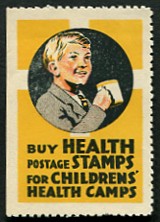
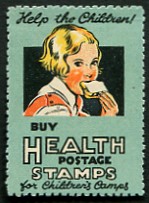
As sales for the 1931 issue had been low, special publicity labels were issued by the Post Office in 1932 and 1933 to promote the sale of health stamps.
There were distributed free to businesses with the idea that they would be put on the back of their business envelopes. The 1932 label shows a boy drinking from a mug and the 1933 issue shows a girl eating a sandwich.
They are printed on unwatermarked paper and are both perf 10, although the shown 1932 value is imperforate on the left side
suggesting that the left sheet margin was not perforated.
1932 Health Plates

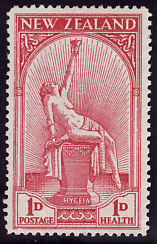
Plates 1 and 2
Two plates of the 1932 issue were made with the etching in copper of the second plate being deeper, especially in the shading in the pedestal.
In the first printing, 750 sheets of 60 stamps were printed from each plate. Subsequent printings were all from the first plate.
The problem with using an etched copper plate is that once the action of acid on the copper has been stopped, it cannot be restarted. Hence, it is difficult to control the depth of the etching and that explains the difference between the two plates.
As the etching in the second plate was deeper, it would have been better able to withstand prolonged use.
However, the shading in the first plate is more subtle
and that may have been the reason why it was used for all later printings.
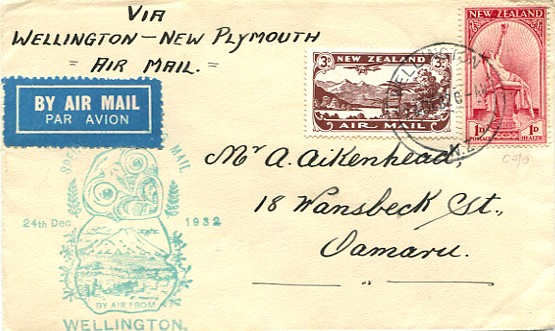
Christmas Special Flight 1932
This Christmas 1932 flight cover, showing a 1932 Health stamp Plate 2, is postmarked in Wellington on 23 December and has routing instructions to be flown from Wellington to New Plymouth. Unusually, it was not backstamped on arrival.
The flight from Wellington to Palmerston North was by G Stedman of the Wellington Aero Club while R Kirkup of the Auckland flew from Palmerston North to New Plymouth.
It is franked with 4d (1d surface, 3d airmail).
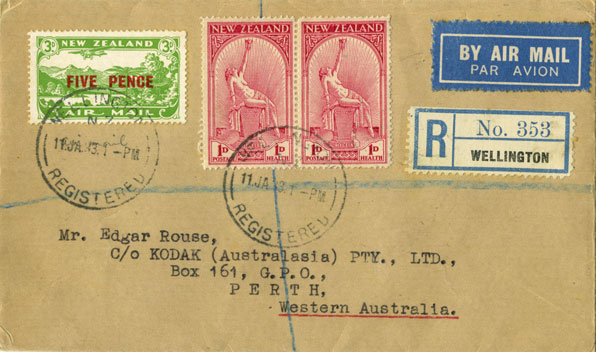
Postmarked January 1933: 1932 Health Stamp
This registered cover showing a pair of the 1932 Health stamp Plate 2 is postmarked in Wellington on 11 January 1933 and is addressed to Perth, Australia.
It would be sent to Sydney by sea and has a Sydney backstamp on 16th January. It then went to Adelaide by rail and was then flown Adelaide - Perth on 21-22 January and is backstamped in Perth on Monday 23rd January.
It is franked with 7d (1d surface, 3d registration and 3d Adelaide - Perth airmail).
Charles Ulm and Scotty Allan Flights: December 1933 and February 1934
Auckland - Invercargill flight, 12 December 1933
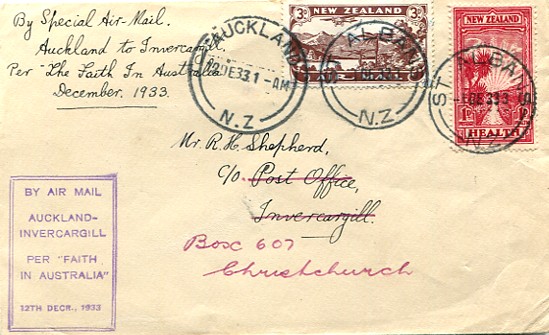
Charles Ulm and G.U. Allan made a "barnstorming" tour of New Zealand to raise funds and to publicise their case for an official airmail from New Zealand to Australia.
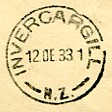
The tour included a non-stop official airmail flight from Auckland to Invercargill on December 12. The demonstration that a non-stop flight could be made from one end of New Zealand to another helped his case for the trans-Tasman airmail. The flight left Auckland at 4.30 am and arrived at Invercargill 8 hours later.
There was a 3d airmail postage rate on top of the ordinary surface rate of 1d. A cachet was applied at Auckland and a backstamp on arrival at Invercargill.
The next example was postmarked in St Albans on 1 December and then again in Auckland on 12 December.
It is franked with the 3d airmail as well as the 1933 Health Stamp.
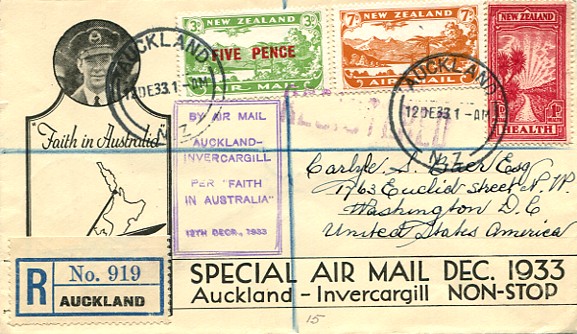
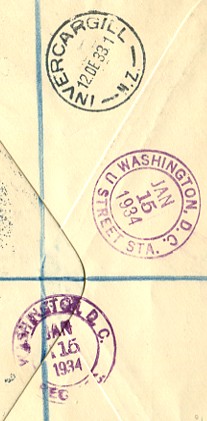
Another cover flown by Ulm and Allan on the special flight from Auckland to Invercargill on 12 December 1933. It is franked with 1s 1d and is addressed to Washington D.C. where it was backstamped on 15 January 1934.
The airmail rate for the flight to Invercargill was 3d in addition to 1d surface rate. The additional rate to be flown on USA airmail services was 4d and the registration rate was 3d which gives a total of 11d.
Likely sent from Wellington on 27 December on the SS Maunganui
which arrived in San Francisco on 13 January 1934.
That fits with the Washington D.C. backstamp.
First Official Trans Tasman airmail, 17 February, 1934
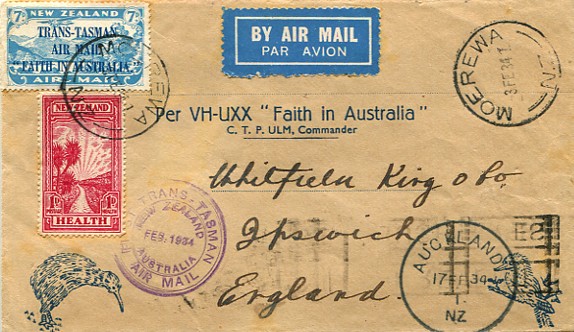
Cover to UK flown on the first official airmail between New Zealand and Australia which took place on 17 February, 1934. Charles Ulm was the pilot, Scotty Allan the navigator/co-pilot and R.T. Boulton was the engineer.

Postmarked in Moerewa on 3 Februray and again in Auckland on 17 February and
backstamped in Sydney later on 17 February.
It is franked with 8d with the extra 1d for surface to the UK.
After arriving in Sydney, it would have been sent to Perth by train and
connect with the S.S. Ballarat from Fremantle on 26 February.
It reached London on 24 March.
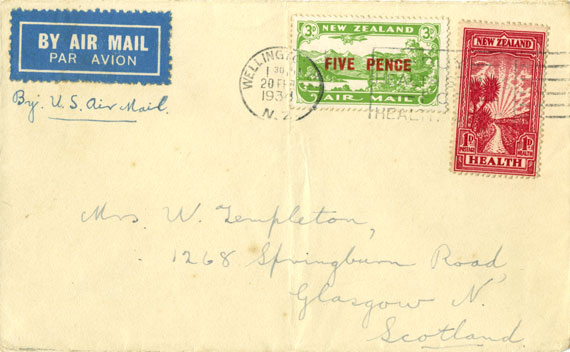
To Scotland via USA February 1934
This cover showing a 1933 Health stamp is postmarked in Wellington on 20 February 1934 and is addressed to Glasgow, Scotland.
It was sent to San Francisco by sea on the Maunganui, flown across the USA and then sent by sea across the Atlantic.
It is franked with 6d (1d surface plus 5d air mail to UK via US airmail).
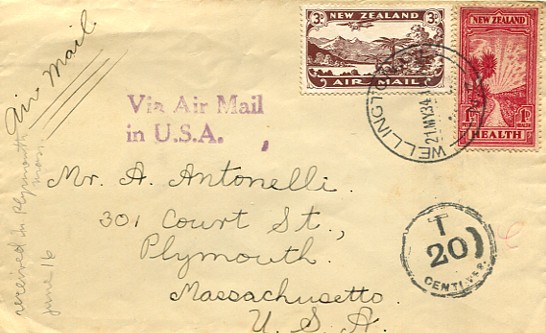
To USA, May 1934
The next cover is to Plymouth, Massachusetts and is postmarked in Wellington on 21 May 1934. It has a Via Air Mail in U.S.A. cachet.
The postage rate was 5d (1d surface plus 4d air mail in USA), but it is only franked with 4d and so has a postage due charge of 20 centimes. Perhaps the sender thought that the 1d surcharge on the 1933 Health stamp would count towards the postage.
It would be sent to Vancouver on the Niagara on 29 May - 15 June
and enter the US postal system at Seattle.
It has received in Plymouth, Mass, June 16 in manuscript on the front
The above information is taken from The Postage Stamps of New Zealand Vol 1, published by the Royal Philatelic Society of New Zealand in 1938. All scans were made by the author.